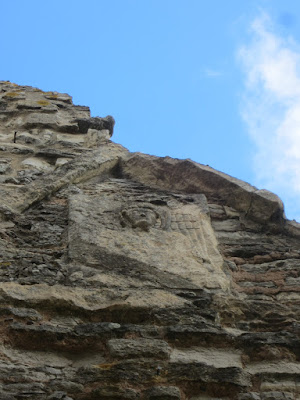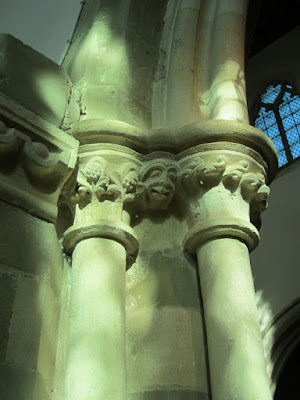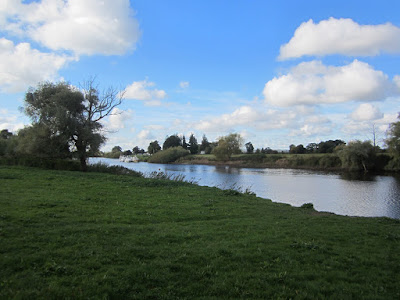First stop, Odda's Chapel, which Earl Odda, a relative of King Edward the Confessor, had built for the benefit of the soul of his brother, Ælfric, who died nearby in 1053.
Dedicated in 1056, it was incorporated into a 16th or early 17th century farmhouse, its nave being turned into a kitchen and its chancel a bedroom. Like St Laurence's, the Saxon church in Bradford-on-Avon, it was only in the second half of the 19th century that it was 'rediscovered' and separated from the farmhouse, itself an impressive historic building.
This is a copy of the original stone with the dedication inscription that is now held in the Ashmolean in Oxford. It was discovered in 1675, entangled in the roots of a nearby apple tree which was blown down in a storm.
‘Earl Odda ordered this royal hall to be built and dedicated in honour of the Holy Trinity for the soul of his brother Ælfric, taken up from this place. Ealdred was the bishop who dedicated the building on the second day before Ides of April in the fourteenth year of the reign of Edward, king of the English’
Odda's Chapel is just the sort of church I love - a small, dark, rural place of worship. Having found St Laurence's deeply affecting, I was expecting a tidal wave of history crash down on me, but - oddly - I didn't feel it.
 My chief presentiment - because I've decided you can have a presentiment about the past - was that cows had probably been kept in there at some point.
My chief presentiment - because I've decided you can have a presentiment about the past - was that cows had probably been kept in there at some point.  On to the Priory Church of St Mary, which is 300 years older than Odda's Chapel, its contruction having commenced by at least 800AD, and possibly during the late 6th century.
On to the Priory Church of St Mary, which is 300 years older than Odda's Chapel, its contruction having commenced by at least 800AD, and possibly during the late 6th century.
If what we know of the history of the church is anything to go by, Deerhurst was an important site in the territory of the Saxon Hwicce, a subkingdom of Mercia. Excavations have uncovered remains of the Saxon monastery, with 7th century burial remains.
I was captivated by these very much more modern headstones in the churchyard, a full millennium older.
 Although tucked away in a village, St Mary's is an important church and knows it. What's more, it was full of wedding flowers from the previous day and bustling parishioners arranging homely-looking apples and small, decorative pumpkins ready for the Harvest Festival, which was due to start presently.
Although tucked away in a village, St Mary's is an important church and knows it. What's more, it was full of wedding flowers from the previous day and bustling parishioners arranging homely-looking apples and small, decorative pumpkins ready for the Harvest Festival, which was due to start presently.
 ... so I was startled to feel the weight of centuries - all those lives! - settle on my chest and in the base of my throat. By the time the vicar came over to ask me to stay to the service, I was overwhelmed to the point of tears. She probably thought I was a bit bonkers.
... so I was startled to feel the weight of centuries - all those lives! - settle on my chest and in the base of my throat. By the time the vicar came over to ask me to stay to the service, I was overwhelmed to the point of tears. She probably thought I was a bit bonkers.
 Small chapel at the end of the north aisle - herringbone stonework, a tomb chest and tomb slabs and brasses on the floor
Small chapel at the end of the north aisle - herringbone stonework, a tomb chest and tomb slabs and brasses on the floor
 One of the beast heads now on either side of the inner door but which would have originally flanked the outer door
One of the beast heads now on either side of the inner door but which would have originally flanked the outer door
 And then there's the font. 'Discovered' - like so many others - being used as a trough in the field over 100 years ago, it is acknowledged as the finest Saxon font in existence, being carved from a single block of limestone with a spiral decoration.
And then there's the font. 'Discovered' - like so many others - being used as a trough in the field over 100 years ago, it is acknowledged as the finest Saxon font in existence, being carved from a single block of limestone with a spiral decoration.
I want to go back and study it when it isn't all lit up.
 A mysterious sign saying 'To the Angel' took me around the outside of the church to the ruined 9th century apse, high on the remaining wall of which ...
A mysterious sign saying 'To the Angel' took me around the outside of the church to the ruined 9th century apse, high on the remaining wall of which ...
 Back in the churchyard, nature bestowed her own harvest upon me - conkers from a horse chestnut and high above, six ravens having a natter. Here are three of them, the others being barely visible in cloud.
Back in the churchyard, nature bestowed her own harvest upon me - conkers from a horse chestnut and high above, six ravens having a natter. Here are three of them, the others being barely visible in cloud.
I'd noticed that the footpath through the churchyard was on top of what looked like a modern dyke. There were floodgates too, between the two churches, and a couple of depthmarkers. I decided to see how close the culprit was.
On the way to the river I passed this oak with the perfect writing room and a desire path leading towards it.
And there, one field away, was the River Severn, strangely dark despite the beautiful October sun, as if it already has some tricks up its long, barely wrinkled sleeve.
I was captivated by these very much more modern headstones in the churchyard, a full millennium older.
 Although tucked away in a village, St Mary's is an important church and knows it. What's more, it was full of wedding flowers from the previous day and bustling parishioners arranging homely-looking apples and small, decorative pumpkins ready for the Harvest Festival, which was due to start presently.
Although tucked away in a village, St Mary's is an important church and knows it. What's more, it was full of wedding flowers from the previous day and bustling parishioners arranging homely-looking apples and small, decorative pumpkins ready for the Harvest Festival, which was due to start presently. ... so I was startled to feel the weight of centuries - all those lives! - settle on my chest and in the base of my throat. By the time the vicar came over to ask me to stay to the service, I was overwhelmed to the point of tears. She probably thought I was a bit bonkers.
... so I was startled to feel the weight of centuries - all those lives! - settle on my chest and in the base of my throat. By the time the vicar came over to ask me to stay to the service, I was overwhelmed to the point of tears. She probably thought I was a bit bonkers.  Small chapel at the end of the north aisle - herringbone stonework, a tomb chest and tomb slabs and brasses on the floor
Small chapel at the end of the north aisle - herringbone stonework, a tomb chest and tomb slabs and brasses on the floor One of the beast heads now on either side of the inner door but which would have originally flanked the outer door
One of the beast heads now on either side of the inner door but which would have originally flanked the outer door And then there's the font. 'Discovered' - like so many others - being used as a trough in the field over 100 years ago, it is acknowledged as the finest Saxon font in existence, being carved from a single block of limestone with a spiral decoration.
And then there's the font. 'Discovered' - like so many others - being used as a trough in the field over 100 years ago, it is acknowledged as the finest Saxon font in existence, being carved from a single block of limestone with a spiral decoration. I want to go back and study it when it isn't all lit up.
 A mysterious sign saying 'To the Angel' took me around the outside of the church to the ruined 9th century apse, high on the remaining wall of which ...
A mysterious sign saying 'To the Angel' took me around the outside of the church to the ruined 9th century apse, high on the remaining wall of which ...  Back in the churchyard, nature bestowed her own harvest upon me - conkers from a horse chestnut and high above, six ravens having a natter. Here are three of them, the others being barely visible in cloud.
Back in the churchyard, nature bestowed her own harvest upon me - conkers from a horse chestnut and high above, six ravens having a natter. Here are three of them, the others being barely visible in cloud. I'd noticed that the footpath through the churchyard was on top of what looked like a modern dyke. There were floodgates too, between the two churches, and a couple of depthmarkers. I decided to see how close the culprit was.
On the way to the river I passed this oak with the perfect writing room and a desire path leading towards it.
And there, one field away, was the River Severn, strangely dark despite the beautiful October sun, as if it already has some tricks up its long, barely wrinkled sleeve.























I visited Odda's Chapel after Tewkesbury Medieval Reenactment this year, it's only down the road. Great post, really sums the place up, thanks.
ReplyDeleteThanks, Vicki. I'm definitely inclined to go back there before long, on a day when there are fewer people about.
Delete